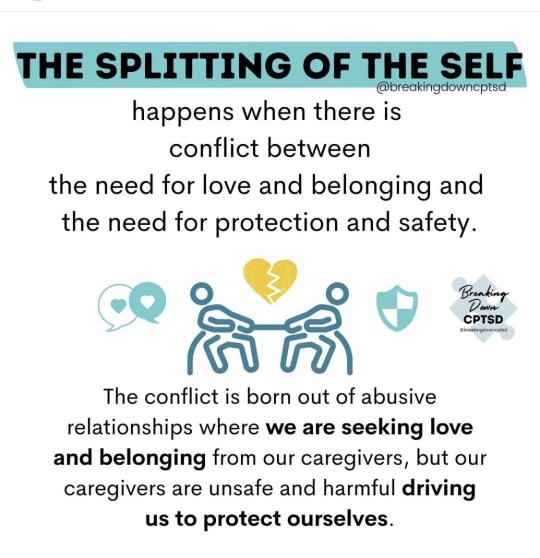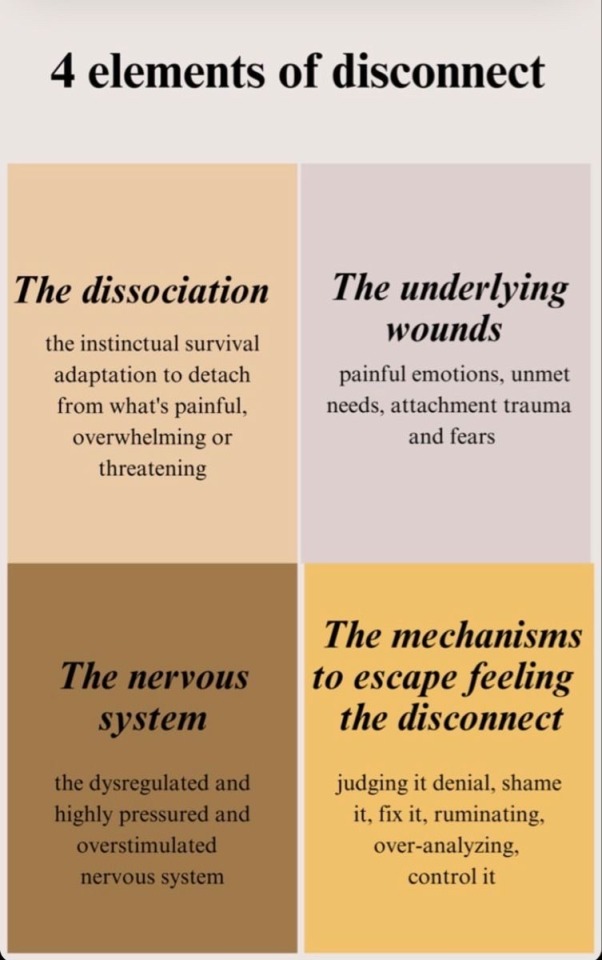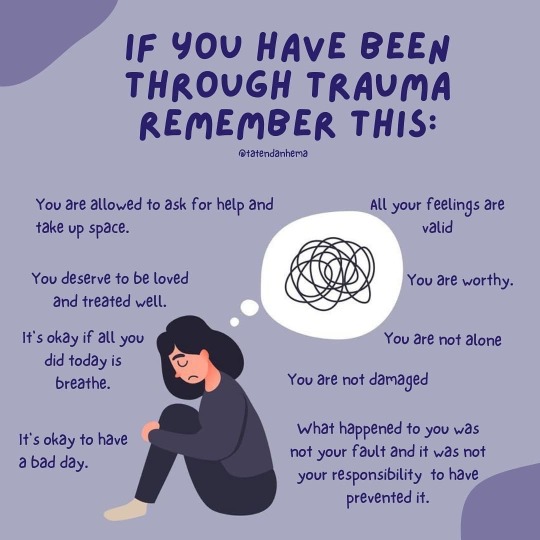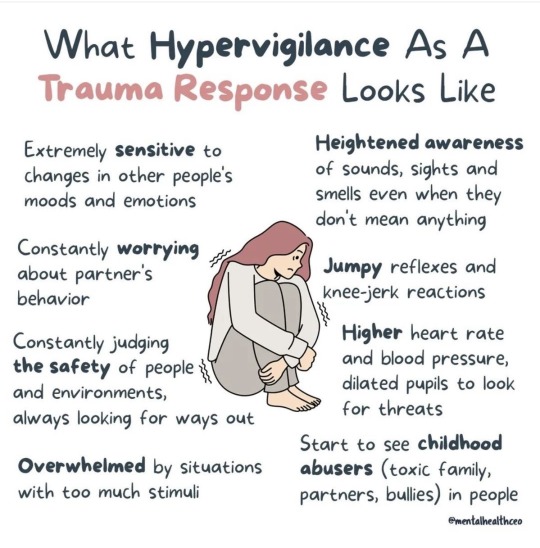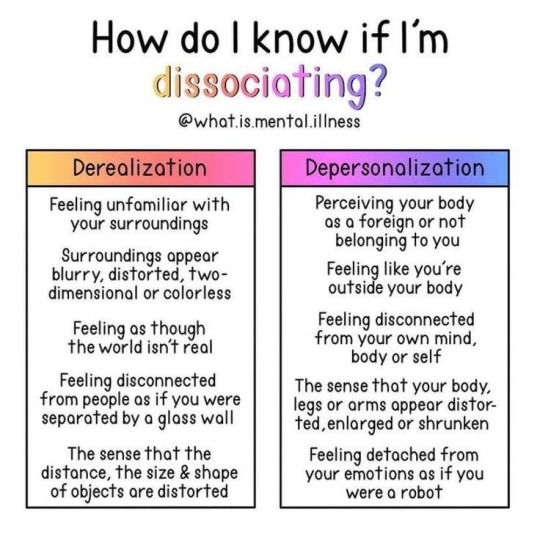Text
When you are overwhelmed:
Find a quieter place
I find it helpful to go outside or on a short walk, possibly with some soft music or white noise.
Getting away from loud or overlapping sounds helps immensely
I also prefer dimmer lights or natural lighting when possible.
Hydrate
Water is essential for all bodily functions, including sensory and emotional regulation.
Have your preferred water bottle with you and sip slowly. Add flavouring or ice if desired
Eat something
Again, taking care of your needs is key
If possible, get a small snack and eat slowly. My system usually keeps oyster crackers with us. They’re bland but have a good amount of salt which is important for us, as we have POTS
Most of our overstimulation is caused by being hungry and not realising it
Identify irritating clothing
Is an article of clothing too tight? Are you too cold or too warm? Is something itching?
Once you’ve identified anything that’s uncomfortable, make any adjustments you can that will remedy the issue
These solutions don’t have to be conventional to be effective. Flipping socks inside out can prevent you from feeling the seams. Dabbing cool water on your wrist and/or ankles can help cool you down.
Stimming
Stimming, or self-stimulatory behaviour, can help calm you down.
Safely stimming can include tapping your fingers, chewing gum, rocking back and forth etc.
There are also stim toys and chewable necklaces for this purpose. I have recommendations if anyone needs them
Identify and Devise a Solution
What led you to feeling overwhelmed?
Write down, either physically or digitally, what caused this and start to plan a solution
If it is a problem with completing a task, We use an app called Goblin Tools. It’s free on the website and the app is $0.99, neither of which have ads. It has a to do list that uses AI to break down your task into steps. It also has a feature to identify tone in writing among other things.
Break down your plan into small, manageable pieces. You don’t need to do everything right now.
Final steps
Communicate your needs to others. If you need to adjust your environment or tasks to accommodate your needs, tell others clearly what you need and how they can help
Breathe. You’re going to be okay. You are not a failure for needing to take a break. You are not a failure for being unable to take on everything at once.
You’ve got this
- Levi
459 notes
·
View notes
Text
Parts of PTSD that no one talks about
Not knowing who to be angry at.
Being angry with yourself for letting it happen even if there was no way to stop it.
Crying and not knowing why.
Flashbacks where nothing bad is happening but it feels bad.
Denying that it ever even happened because your brain doesn't want to process it.
Wanting to go back to it so it feels "bad enough."
Intentionally triggering yourself to feel like your suffering is real.
Being angry all the time at every little thing.
Getting triggered by minor things and then being treated poorly because of your reaction to said trigger.
Hating change.
Being scared to sleep because you know you'll have nightmares.
Struggling to find hobbies that you enjoy.
Feeling like you're barely human.
Struggling to be positive about anything at all.
Feeling like you may be manipulating people around you into liking you.
Feeling like no one believes you because you barely even believe yourself.
Treating your past self as a "dead" version of you and feeling like a completely different person.
Being tired all the time, both physically and mentally.
Feeling like if you talk about it, your safety will be at risk.
Feeling the need to hide your trauma from everyone, including professionals there to help them.
Being paranoid everyone is going to hurt you.
Being physically incapable of talking about it.
Feeling like you're stuck reliving your trauma.
Having to skip classes or work days because of flashbacks.
Mourning your past self.
Wanting to hurt others so they feel what you feel.
Wondering why it had to be you and it wasn't someone else.
Chronic pain.
Clinging to "safe people."
Not being able to find a solid sense of identity.
Forcing yourself to be around people who trigger you for the sake of politeness.
1K notes
·
View notes
Text
Self improvement is great but ultimately? you have to accept your self. Yes you can eat better, exercise more, read more, set boundaries, love your self, but it all comes down to this. Some days you won’t have the energy to do any of these things. And you’ll look in the mirror and think that this is not enough. That’s a lie. The biggest love for self is to live slowly. To rest. To really rest. Have a nap. Eat what makes you feel good. Read if you want to. Embrace yourself and accept that you cannot and will not be ever be perfect. Accept that you are good enough. You don’t need to keep busy all the time. you don’t need to go out all the time and post on instagram. You don’t need to journal if you don’t want to. You don’t need to make art if you don’t want to. Breathe, give yourself grace and compassion. Give yourself the love and tenderness you so badly need. Be gentle with yourself. You are trying and it is good enough. You are good enough.
54K notes
·
View notes
Text
If anyone's looking for really gentle or disability friendly exercise...
Doctor Jo on YouTube is a physical therapist who offers lots of therapeutic stretching and exercise videos for specific conditions and pain relief. [x]
Leap Services is a Canadian physical therapy group that has a YouTube playlist of gentle exercise routines. All of these exercises are done in a chair (except for one which is done on the floor) and are intentionally adaptable to different bodies and needs. [x]
Yoga with Zelinda on YouTube has yoga that's adapted to a large number of conditions, for instance, providing a playlist of routines that don't require kneeling and another of chair yoga. She also offers yoga for specific health challenges, like fibromyalgia and mobility issues. There's a playlist of yoga routines for people with bigger bodies as well. [x]
Santosha Spirit on YouTube has yoga routines for people with chronic fatigue, chronic pain, POTS, and EDS. [x]
Yoga with Shaunneka on YouTube has a playlist of slow seated yoga, including chair yoga, as well as a playlist of gentle yoga. [x]
Qinergy on YouTube has tai chi sets broken down into easy tutorials. There is a seated version of her shibashi set. [x]
Perth Tai Chi Academy on YouTube is similar to Qinergy. It provides a seated version of daoyin yangshen qigong. [x]
14K notes
·
View notes
Photo

Dissociative amnesia occurs in varying degrees. For example, individuals may be unable to recall certain parts of a memory, or may know what happened, but not recall the episode with a sense of personal ownership (“It happened, but not to me”). Dissociative amnesia is a disorder in its own right (APA, 1994; Loewenstein, 1996; Van der Hart & Nijenhuis, 2001).
- The Haunted Self, Onno van der Hart, Ellert R. S. Nijenhuis, and Kathy Steele
101 notes
·
View notes
Text
My other blog previosly @dissociatedaze has been changed to a different name (DM me for that personal blog) and this blog will now be devoted to resources for recovery.
0 notes

